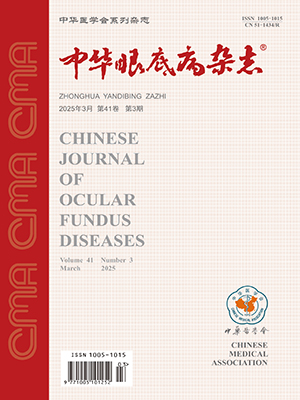Objective To summarize the therapeutic effect and clinical characteristics of repetitive photodynamic therapy (PDT) for patients with exudative age-related macular degeneration (AMD). Methods The clinical data from 78 patients (94 eyes) with exudative AMD who had undergone PDT from July, 2002 to March, 2005 were retrospectively analyzed. The average age of the patients was 68.4, and the treated times was 132 (mean 1.4). Thirty eyes underwent PDT 68 times, including twice in 22 eyes (73.3%), 3 times in 7 eyes (23.3%), and 6 times in 1 eye (3.3%). The follow-up period lasted 3-32 months with the average of 16.7 months. Results In the final follow-up examination, the results of fundus fluorescein angiography or combined with indocyanine green angiography showed that the leakage of choroidal neovascularization (CNV) stopped in 14 eyes (46.7%), reduced in 12 (40%), and remained in 4 (13.3%). Compared with the condition before first PDT, the correct visual acuity increased ge;2 lines in 7 eyes (23.3%), changed plusmn;1 line in 14 eyes (43.3%), and decreased ge;2 lines in 9 eyes (30%) in the final examination. After first PDT, the best corrected visual acuity increased ge;2 lines in 13 eyes (43.3%), changed plusmn;1 line in 12 eyes (40%), and decreased ge;2 lines in 5 eyes (16.7%). During the follow-up period, the best corrected visual acuity occurred after first PDT in 24 eyes (80%), after second PDT in 5 eyes (16.7%), and after third PDT in 1 eye (3.3%). Conclusions In patients undergone repetitive PDT, CNV in most of the affected eyes completely or partly closed and the visual acuity improved or remained still in 67.8% of the patients in the final follow-up examination. The best correct visual acuity mainly happened after the first PDT, and as the times of PDT increased, the probability of the best correct visual acuity decreased. (Chin J Ocul Fundus Dis, 2006, 22: 220-223)
Citation: DAI Hong,YU Xiaobing,LU Yingyi,et al.. Clinical observation on repetitive photodynamic therapy for exudative age-related macular degeneration. Chinese Journal of Ocular Fundus Diseases, 2006, 22(4): 220-223. doi: Copy
Copyright © the editorial department of Chinese Journal of Ocular Fundus Diseases of West China Medical Publisher. All rights reserved




